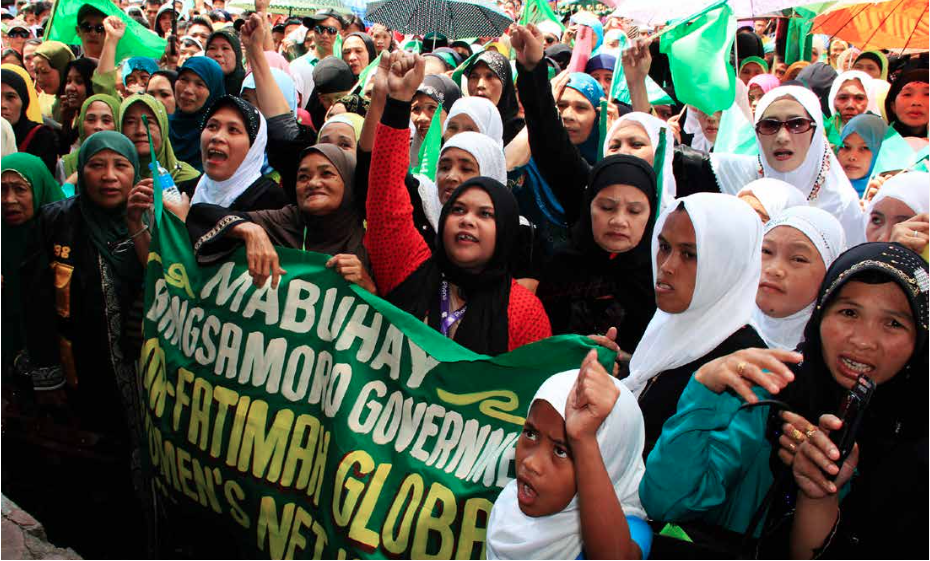“TRUTH HURTS, but ‘truth sets you free,’” Moro Islamic Liberation Front (MILF) Chief Negotiator Mohagher Iqbal told Senator Miriam Defensor-Santiago at the Senate hearing on the Mamasapano clash last February.
Santiago, chairperson of the Committee on Constitutional Amendments, interrogated the MILF representative regarding the Moro group’s knowledge of foreign terrorists Zulkifli bin Hir (alias Marwan) and Abdul Basit Usman’s affairs. Iqbal explained that the truth behind what Santiago called a “perfidious tragedy” must be known in order for the peace process to ensue.
The senator replied: “There are many, many truths, Mr. Iqbal.”
The hearing discussed the police operation aiming to extract the said terrorists from Mamasapano, Maguindanao. The area had residents who were members of the MILF and the Bangsamoro Islamic Freedom Fighters (BIFF), another insurgent group. The encounter left 44 members of the Philippine National Police-Special Action Force (PNP-SAF) and 18 members of private armed groups dead.
The ensuing ripple caused criticism regarding the lack of government coordination, and drove a rift between the trust among members of the state and MILF. It endangers the passage of the Bangsamoro Basic Law (BBL), the supposed fruit of negotiations that establishes the self-governing political entity called the Bangsamoro, placing the peace process on the verge of a relapse.
The clash
Dean Julkipli Wadi of the Institute of Islamic Studies at the University of the Philippines-Diliman clarified that the event was not a massacre. “[The term massacre is used in] the case where a group with overwhelming use of force used that force against helpless individuals,” he said. “What happened was a real combat between the [PNP-SAF] and a group of armed men belonging to collections of [MILF and BIFF].”
Iqbal said that the MILF was willing to help the government find Usman, but his claim that the MILF did not know the terrorists were present in Mamasapano has been cause for skepticism.
Wadi explained that although the BIFF broke away from the MILF, their culture has a strong kinship system. “In reality, they continuously stayed in one place,” Wadi said. “[That] area, like many other parts of Maguindanao, could really be ripe for kind of a mixture and grouping of different armed groups, where it is very difficult to delineate one from the other.”
Their relationship is accentuated not only by their history, but also by their familial relations that make their predicament personal. “Could you imagine [the] dilemma [of the] MILF? They were comrades-in-arms before, tapos ito, tayo na ngayon magkasama na dati’y magkaaway (we who were enemies before are working together now),” Wadi said. “Mahirap ‘yon (That is difficult).”
Gray area
Nonetheless, Wadi believes that the MILF is sincere. However, he adds that because the clash took place prior to the decommissioning of MILF weapons in line with the peace agreement, the relationship between the MILF and government was in a gray area.
Santiago suggested renogotiating the peace deal, believing its foundation to be questionable. “Where is the Senate authorization for the president to conduct this negotiations?” she asked. “Who gave the MILF authority to represent the Bangsamoro among all those scions of the breakaway groups such as the MNLF (Moro National Liberation Front), BIFF and others now screaming to existence?”
Fr. Albert Alejo, SJ said in a forum last month, “We’re dealing with the more moderate of the Muslim armed groups, and that [is] why we should empower [them]. Otherwise, you allow these people to be in control.” However, he added it would be ideal if the MILF sat down with their MNLF counterparts and just drafted one agenda for all Moro groups.
Another possible answer, Wadi expresses, is that the MILF is in the middle of a reconfiguration process. “[It] decelerated its formation along the Islamic line and recast its image to become like any other national liberation movement,” he said. Its approachability may be what makes it a good candidate for negotiations.
“What the strategy is, there should be at least one group that the government would be able to talk to—even if it is not serious—in order to project a semblance of peace in Mindanao,” said Wadi, saying that the government cannot afford to have so many insurgent groups against them. The move, he said, also attracts the international community to invest in the Philippines.
Reservations
The BBL has received flak for being unconstitutional, with Santiago saying that it attempts to redefine Philippine sovereignty and could even facilitate secession. “[The] Agreement not only reduces the sovereignty of the central government, but also provides that in the future, such sovereign powers as have been reserved may be further increased, provided the Bangsamoro agrees,” said Santiago of a passage in the law that allowed for changes in the Constitution. “It will therefore be the Bangsamoro which will determine what should be the remaining sovereign powers of the central government.”
“It’s not only the draft BBL itself, but it is also the lens we use in looking at [it]. If you’re coming from the perspective of mega-conservatism, you will stop reading at the preamble,” said Wadi in mixed English and Filipino. “But if you’re coming from a lens of carrying a very broad perspective [on] the legality of Constitution… the BBL has a place.”
Senator Allan Peter Cayetano on the other hand has also been vocal, even tagging the MILF a terrorist group. ARMM Governor Mujiv Hataman countered his use of the term. “I am not siding with the MILF, but do we tag the [New People’s Army] as terrorists when they burn down equipment?” he said. He also said that Cayetano’s citation of the Al Barka incident as evidence of MILF violence was inaccurate, because that killing actually involved the Abu Sayyaf Group. Cayetano has nonetheless kept his stance, believing that the MILF will join other terrorist groups once provided with funding for the Bangsamoro.
Construction and coordination
With the recent turmoil, the target passage of the BBL before recess of Congress starting March 19 has become hardly attainable. With a culture of policy discontinuity, the likelihood of the BBL being passed at all is low.
Wadi says that the process can be likened to blueprinting and building a house. “Something went wrong…there, it was destroyed again. So by 2016, you would have to build another one. You will come up with a new blueprint,” he said in a mix of English and Filipino.
The discontinuity among administrations does not stay there–it also moves across offices. “The peace talks [are] an initiative of the executive. If I were in the MILF, my perception is, I am speaking to the government. In reality, you are talking only to the executive,” said Alejo in mixed English and Filipino, adding that the legislative branch must still approve this. “Now, there should be internal polished equation between and among the three branches.”
Due to the circumstances, the Senate and the House of Representatives have agreed, in a March 2 legislative meeting, to push the deadline to June. Alejo believes that the peace process must continue despite the delay of its approval.
“We have to pursue the peace process, but the peace process is bigger than the immediate approval of the BBL… The MILF should accept the fact that it is delayed but does not mean that it is forever forfeited,” Alejo said. “The rest of the country should be educated [that] the delay does not mean we will go into all-out war.”
Wadi agreed that a lot more must be done after the passage of the law. “Do not look at the BBL as the be-all and end-all of things,” he said. “It is just a phase… It is a continuing journey.
[columns][two-columns] The Lumads of Bangsamoro
By Janella H. Paris and Frances P. Sayson
The proposed Bangsamoro territory agreed upon by the government and the Moro Islamic Liberation Front (MILF) is envisioned as a geographical, political and fiscal entity more stable than the Autonomous Region of Muslim Mindanao. It is a large region, encompassing almost 35,000 square kilometers and four million people of various ethnicities.
Mindanao’s inhabitants are often categorized into Christians or migrant settlers, Moros or Muslims, and the lumads or non-Muslim and non-Christian indigenous peoples (IPs). There are 18 lumad groups, including the Manobo and the Teduray. Their inclusion in the Bangsamoro has been contentious.
Reservations
The Erumanen ne Menuvu, a major Manobo group, have requested that their ancestral territories be excluded from the Bangsamoro region. “We cannot accept Bangsamoro as our identity. We have our own identity and this is the Erumanen ne Menuvu,” said Erumanen Datu Ronaldo Ambangan in the congressional consultations last June 2014.
Likewise, some Tedurays, such as Fintailan Mokudef and Timuay Alim Bandara, have voiced their concern that the rights of IPs are being set aside in negotiations. Rights over their ancestral lands are the most important for these tribes, and Bandara has expressed his worry over land claims and hopes that land titles are settled before the Bangsamoro state is declared.
Other Manobo chieftains, such as Datus Eduardo Banda of Cotobato and Roldan Babelon, also of the Erumanen, have also raised reservations on the fate of the indigenous people under the territory.
Sound worries
Land ownership for the lumads, determined by ancestry, is highly prized and traditional. According to the Institute for Autonomy and Governance (IAG), “land is life” for the Teduray.
Under the Bangsamoro Basic Law (BBL) draft, the Bangsamoro government has exclusive power over ancestral domain. The draft is also unclear on technicalities—only native titles of IPs are mentioned, in contrast with the Indigenous Peoples Rights Act, where ancestral domain, lands and native titles are “clearly defined and distinguished,” according to the IAG.
Industrial developments have also displaced IPs, with hundreds of hectares, including lumad ancestral territories, covered by mining tenements.
Lumads have also been greatly affected by encounters between the military and the MILF. On October 2014, two lumad men were killed and two went missing during military operations. In the same month, a Teduray tribe leader was killed in an ambush. Conflicts have also displaced hundreds of thousands of lumads, who have also complained of harassment by armed men identified as MILF members.
Solutions
After the Mamasapano tragedy that killed 65 people in Maguindanao late in January, legislators are even more divided on the issue of the BBL. In Congress, the ad hoc committee on BBL has been convening since the tragedy, with Representative Nancy Catamco vying for the inclusion of IP rights.
But before the Bangsamoro and the BBL are made official, IPs still have reason to doubt. “[The BBL] will damage our inherent and inalienable right to self-determination,” Ambangan says, referring to the self-determination that they are neither Christians nor Muslims, but rather, lumads. [/two-columns]
[two-columns]Violence in Mindanao
By Chynna A. Santos
Sources: Rappler, Inquirer.net, MindaNews, Luwaran.net
The clash in Mamasapano, Maguindanao between the Philippine National Police-Special Action Force (PNP-SAF) and the Moro Islamic Liberation Front (MILF) that resulted in the deaths of 44 of the PNP-SAF officers has been called many things—a massacre, a misencounter, a battle, a disaster, a tragedy.
However, this is not the first time blood has been spilt on Mindanao soil, and these acts of violence have created tensions and hindered peace processes over the years. Beyond Loyola sheds light on the other times men and women died in this long-running conflict.
Jabidah massacre
Who: AFP–Moro-Muslim military recruits
When: March 18, 1968
Where: Corregidor Island
What and why: When Moro recruits in the AFP were told of their mission to annex Sabah from Malaysia back to the Philippines, they refused on the grounds that they would be fighting fellow Muslims and possible relatives in the area. After the mission failed to push through, the recruits were taken to an airstrip on Corregidor Island and shot with machine guns. Reports place the number of deaths somewhere between 11 and 200.
Tacbil Mosque massacre
Who: AFP–Moro civilians
When: September 24, 1974
Where: Malisbong, Sultan Kudarat
What and why: Considered one of the many military atrocities during Martial Law, the incident—also known as the “Malisbong Massacre”—took place inside a mosque, where more than 1,000 (numbers vary) praying civilians were gunned down by military forces in pursuit of Moro National Liberation Front (MNLF) rebels.
Pata Island massacre
Who: AFP–MNLF
When: February 12, 1981
Where: Pata Island, Sulu
What and why: The Pata Island massacre saw 119 officers gunned down and “hacked to death” by villagers and MNLF rebels. The incident has the largest number of casualties sustained by the AFP in a single encounter. In retaliation, both the navy and the air force shelled the island continuously for months, resulting in 200 to 3,000 civilian deaths.
SuperFerry bombing
Who: Civilians – Abu Sayyaf
When: February 27, 2005
Where: Manila Bay
What and why: Six members of the Abu Sayyaf placed a bomb onboard the SuperFerry 14, which was en route to Bacolod. The explosion led to a fire, and the two together killed 116 of the 900 passengers. Only 63 bodies were recovered. The government initially downplayed the Abu Sayyaf’s role in the explosion, claiming it was an accident, before investigators found evidence of sabotage onboard.
Al-Barka clash
Who: AFP–MILF
When: October 18, 2011
Where: Al-Barka, Basilan
What and why: The MILF claims that the military opened fire at them during what should have been a ceasefire, prompting the former to shoot back. The AFP, on the other hand, says they were far from the site of the MILF stronghold, and were first shot at by the MILF. The AFP members were in the area carrying out an operation against a terrorist group. Nineteen soldiers and six Moro rebels were killed.
Siege of Zamboanga
Who: Armed Forces of the Philippines, PNP, civilians–MNLF
When: September 9-28, 2013
Where: Zamboanga City, Zamboanga
What and why: A faction of the MNLF, dissatisfied with the ongoing peace negotiations between the government and the MILF, stormed Zamboanga City and took hostages. The stand-off lasted 20 days, with more than 100,000 civilians displaced and a death toll of 191.
Mamasapano clash
Who: PNP-SAF–MILF
When: January 25, 2015
Where: Tukanalipao village, Mamasapano, Maguindanao
What and why: PNP-SAF officers were allegedly hunting down Malaysian terrorist Zulkifli bin Hir, better known as “Marwan,” in Mamasapano. A spokesperson for the MILF says they were not informed of the operation, despite the ceasefire supposedly in place, and thus fired back at the PNP-SAF firing on the village. [/two-columns][/columns]




